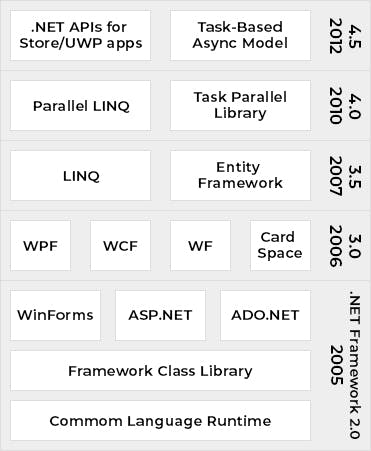.NET is a software framework that is designed and created by Microsoft. The principal variant of .Net framework was 1.0 which came in the year 2002. In simple words, it is a virtual machine for arranging and executing programs written in various languages like C#, VB.Net and so forth.
It is utilized to develop Form-based applications, Web-based applications, and Web administrations. There is a variety of programming languages accessible on the .Net stage, VB.Net and C# being the most widely recognized ones. It is utilized to build applications for Windows, mobile and web. It gives a ton of functionalities and furthermore underpins industry guidelines.

Common Language Runtime: CLR is a run-time environment used to execute the codes written in any .NET programming language.
Framework Class Library: Large number of class libraries are available in the structure which is known as FCL.
Types of Applications: Mainly the applications which are inherent .Net structure is isolated into the accompanying three categories
WinForms: Form – customer based applications which read and composes the document framework goes under this category.
ASP .NET: Web-Based applications go under this classification. Web services were added in .Net Framework 2.0 and considered as a part of ASP.NET web applications.
ADO .NET: It incorporates the application which are created to speak with the database like MySQL, SQLite and PostgreSQL. It mainly consists of classes that can be used to connect, retrieve, insert and delete data.
Windows Presentation Foundation: WPF graphical subsystem also known as “Avalon” given by Microsoft which utilizes DirectX and is utilized in Windows-based applications for rendering UI (User Interface).
Windows Communication Foundation: WCF is a structure for building connected and service-oriented applications used to transmit the information as offbeat starting with one help endpoint then onto the next assistance point.
Windows Workflow Foundation: WF innovation is given by Microsoft which gives a stage to building work processes inside .Net applications.
Card Space: It is a Microsoft dot net framework programming customer which is intended to let clients give their computerized character to online services in a secure, simple and trusted way.
Language Integrated Query: LINQ was introduced in .Net system from version 3.5. Fundamentally, it is a question language used to make the inquiry for information sources with VB or C# programming language.
Element Framework: It is an open–source ORM (Object Relational Mapping) based structure that comes into .Netframework version 3.5. It empowers the .Net designer to work with a database utilizing .Net objects. Prior to the element structure, .Net designers have played out a great deal of things related to database. Like to open an association with the database, designers need to make a Data Set to bring or present the information to the database, convert information from the Data Set to .NET items or the other way around. It makes the troubles for designers and furthermore, it was the blunder inclined procedure, at that point “Substance Framework” comes to computerize all these database-related exercises for the application. Thus, Entity Framework enables the engineers to work at a higher level of abstraction.
Parallel LINQ: Language Integrated Query comes in dot net Framework variant 4.0 and furthermore named as PLINQ. It gives a simultaneous inquiry execution engine for LINQ. It executes the LINQ in parallel with the end goal that it attempts to use as a lot of preparing power framework on which it is executing.
Task Parallel Library: TPL enables the developers to be progressively beneficial by improving the way toward adding concurrency and parallelism to .Net applications.
.NET API For Store/UWP Apps: Microsoft included some APIs in 2012 for making UWP(Universal Windows Platform) applications for Windows utilizing C# or VB.
Task-Based Asynchronous Model: It is a model used to depict the offbeat activities and errands in .Net Framework.
.NET Standard
Since 2016, the .NET ecosystem was improved with a large class library called .NET Standard. It depends on the quantity of base class libraries for dot net Framework, .NET Core and Xamarin. These are utilized to work with normal capacities, for example design rendering, database association, and controls with XML reports. The .NET Standard library enormously improved designer’s work.
Before .NET Standard, Hire a Software Developers to redevelop an application or a library for the new platform and afterward distribute every one of the updates crosswise over different platforms. Presently, the library bolsters every single ward library crosswise over applications. Notwithstanding, you should check adaptation similarity to effectively use .NET Standard.
Why use .NET Programming?
It’s Portable: .net core and Mono are both battle-tested on Windows, Linux and Mac. Microsoft and .net outstanding workloads are clearly well-upheld.
It’s Fun: Unity has become the standard for game designers, particularly for mobile, AR, and VR. Solidarity abandoned UnityScript in 2017, making C# the primary scripting language.
It’s Fast: even faster than you think. .net Core is faster than Java across the board and up to 3x faster than Go on AWS Lambda.
Great Tools: Visual Studio and VSCode are two of the best IDEs available, and they are both free.
Great Languages: C# and F# are both magnificent programming languages. Gainful, expressive, and specifically, these languages include built-in offbeat natives, query expressions, exception handling, and a protected bundle chief. Both are eminently archived, simple to learn, and sponsored by dynamic networks.
Great Ideas: The .net ecosystem gave birth to great ideas like await/async, ReactiveX (FRP), LINQ, and TypeScript.
Thoughtful Evolution: Each new language update includes thoughtful additions that won’t give you whiplash.
Advantage of .NET Framework for Business Application
Scalable products. For the most part, the business needs are developing and your software needs proportional with it. .NET development gives adaptable condition and permits to upgrading continuous applications so as to coordinate with the developing needs of the business.
Cross-platform needs. On the off chance that you need the application that will work crosswise platforms .NET will be the extraordinary decision as most stages are secured and you can decrease advancement exertion while extending your desktop or mobile application to other working OS. In addition, .NET programming can be utilized for such explicit development cases as gaming (counting Xbox) and AR advancement (counting HoloLens).
Enterprise-scale infrastructures It’s as yet a far from being obviously true point whether .NET is structured for the most part for enterprise use. Be that as it may, Microsoft makes a point to give the largest toolset conceivable to build and cross-integrate enterprise products both internal and public ones. It likewise bolsters a vigorous enterprise mobility environment.

